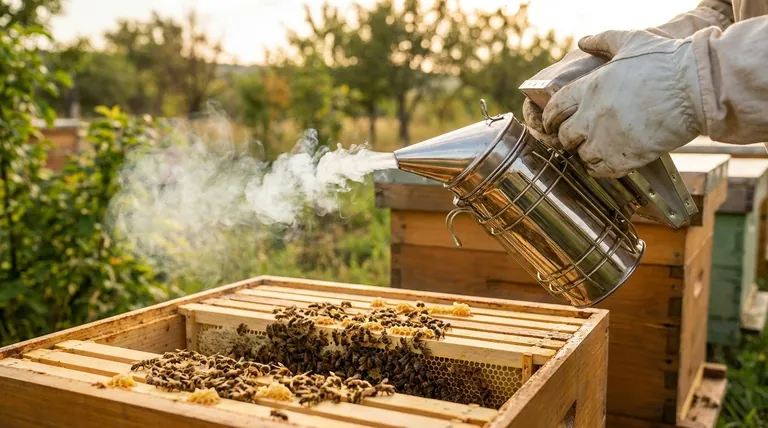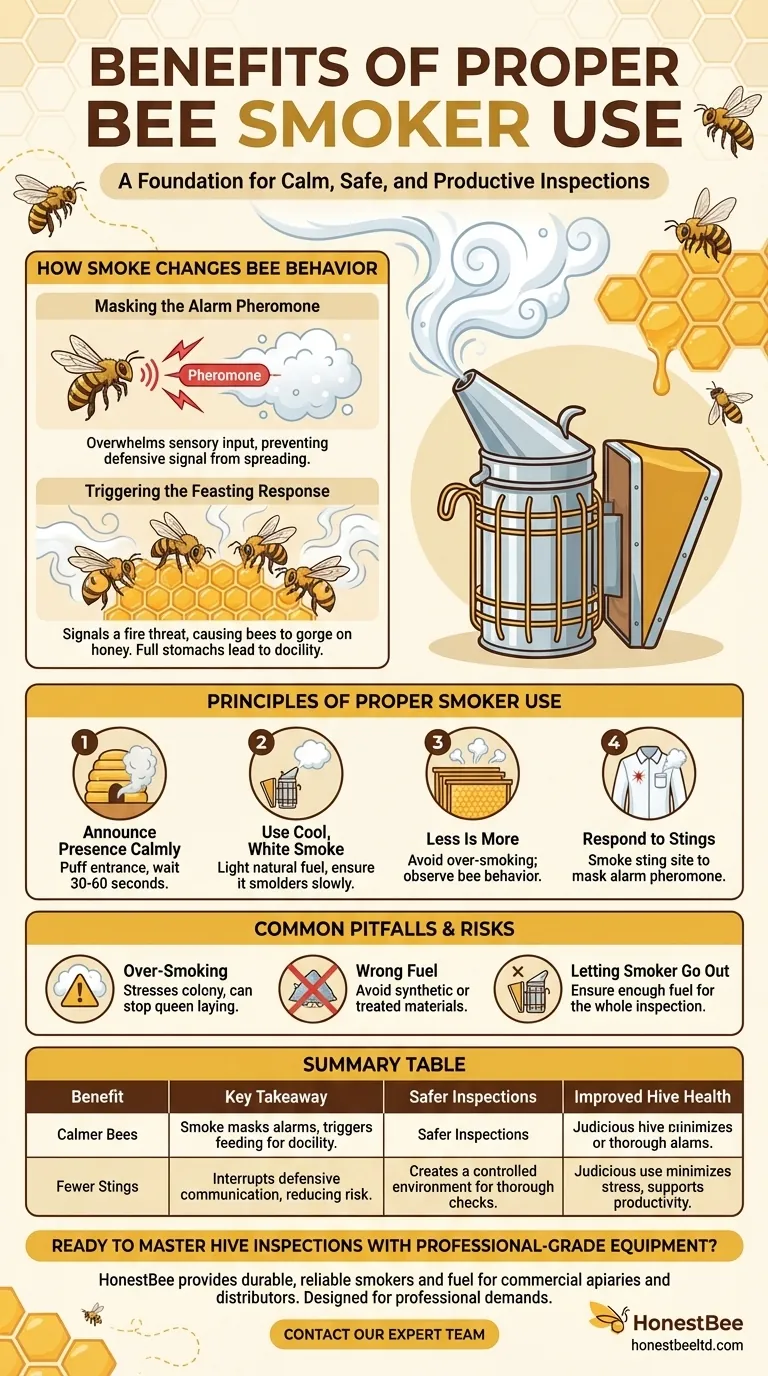Properly using a bee smoker is a cornerstone of responsible beekeeping, ensuring inspections are calm, safe, and productive for both the beekeeper and the bees. The smoke works by interrupting the bees' natural defensive communication and triggering a primal survival instinct. This allows you to manage the hive with significantly less aggression and fewer stings.
A bee smoker is not a tool of aggression; it is a tool of communication. It works by masking the bees' chemical alarm signals and encouraging them to focus on consuming honey, a behavior that makes them physically calmer and less likely to sting.

How Smoke Fundamentally Changes Bee Behavior
Understanding why smoke is effective is the key to using it properly. The effect is twofold, targeting both the bees' ability to communicate danger and their instinctual response to a threat.
Masking the Alarm Pheromone
When a guard bee perceives a threat or is injured, it releases an alarm pheromone. This chemical signal instantly alerts the colony to a danger, triggering a widespread defensive response.
Smoke particles effectively overwhelm the bees' antennae, which they use to "smell." This sensory overload masks the alarm pheromone, preventing the signal from spreading throughout the hive and stopping a defensive chain reaction before it starts.
Triggering the Feasting Response
The presence of smoke signals a potential fire, a primal threat to a honey bee colony. Their instinct is not to fight the fire, but to prepare to evacuate the hive.
To do this, bees will immediately begin to consume large amounts of honey. This ensures they have the energy reserves needed to fly and establish a new home. A bee with a full stomach is more docile and finds it physically more difficult to flex its abdomen to sting.
The Principles of Proper Smoker Use
Effective smoking is about finesse, not force. The goal is to create a calm environment with minimal disruption to the hive.
Announce Your Presence Calmly
Before you even open the hive, gently puff a small amount of smoke into the entrance. Wait 30-60 seconds. This serves as a polite knock on the door, alerting the bees to your presence and triggering the calming responses before you begin your inspection.
Use Cool, White Smoke
The goal is to produce cool, white, thick smoke. Hot, black, or thin smoke is ineffective and can irritate the bees. This is achieved by lighting your fuel source (like untreated burlap, pine needles, or cotton) and then adding more fuel on top to smolder slowly.
Less Is More
A common mistake is using far too much smoke. You are not trying to fumigate the hive. A few gentle puffs across the top of the frames after you open the lid is usually sufficient. Observe the bees' behavior and only add more smoke if they begin to show signs of agitation.
Respond to Stings
If you are stung, the bee will release a potent concentration of alarm pheromone at the sting site. Immediately smoke the affected area on your suit or skin to mask this signal and prevent other bees from being drawn to the spot to sting again.
Understanding the Common Pitfalls
Using a smoker improperly can be counterproductive and even harmful to the colony. Awareness of these mistakes is critical for effective management.
The Risk of Over-Smoking
Blasting a hive with excessive smoke can do more harm than good. It can overly stress the colony, disorient the bees, and in extreme cases, may even cause the queen to stop laying.
Using the Wrong Fuel
Never burn synthetic materials, treated wood, or anything that could release toxic chemicals into the hive. Stick to natural, untreated fuels. Contaminated smoke can harm the bees and taint the honey.
Letting the Smoker Go Out
A smoker that extinguishes mid-inspection is a common frustration. Pack your smoker with enough fuel to last the entire inspection. A well-packed smoker should smolder consistently with only occasional puffs of the bellows.
Making the Right Choice for Your Goal
Your approach to using a smoker should align with your immediate objective during a hive inspection.
- If your primary focus is safety as a new beekeeper: Master the smoker first. It is your single most important tool for preventing stings and building a calm working relationship with your bees.
- If your primary focus is colony health and productivity: Use smoke judiciously. Apply just enough to mask alarms and prevent defensiveness, minimizing stress on the colony.
- If your primary focus is managing an aggressive hive: Be deliberate and consistent. Use the smoker to interrupt their defensive communication before they become agitated, but avoid over-smoking, which can make the situation worse.
A smoker, used with understanding and respect, transforms hive inspections from a potential confrontation into a calm and controlled process.
Summary Table:
| Benefit | Key Takeaway |
|---|---|
| Calmer Bees | Smoke masks alarm pheromones and triggers a honey-feeding instinct, making bees docile. |
| Fewer Stings | Interrupts defensive communication, significantly reducing the risk of stings during inspections. |
| Safer Inspections | Creates a controlled environment, allowing for thorough hive checks with minimal stress to the colony. |
| Improved Hive Health | Judicious use minimizes bee stress, supporting overall colony productivity and well-being. |
Ready to master hive inspections with professional-grade equipment?
As a trusted wholesale supplier to commercial apiaries and beekeeping equipment distributors, HONESTBEE provides the durable, reliable smokers and fuel you need for safe and efficient hive management. Our equipment is designed for the demands of professional beekeeping, helping you protect your colonies and maximize productivity.
Contact our expert team today to discuss your wholesale needs and discover how our beekeeping supplies can benefit your operation.
Visual Guide

Related Products
- European Stainless Steel Bee Smoker for Honey Bee Hive
- Premium Traditional Copper Bee Smoker with Bellows
- Heavy-Duty Bee Smoker with Durable Plastic Bellows for Beekeeping
- Professional Bee Smoker with Elongated Spout and Durable Bellows for Beekeeping
- Heavy Duty Manual Bee Smoker Blower for Beekeeping
People Also Ask
- What are the benefits of cleaning a bee smoker? Ensure Hive Safety and Bee Health
- Can you use too much smoke on bees? The Right Way to Use a Bee Smoker for Calm Inspections
- What are the benefits of smoking bees? Achieve Safer, Calmer Hive Inspections
- What are the steps to operate a bee smoker? Master the Art of Gentle Beehive Management
- How does a smoker help during hive inspections? The Key to Calm, Safe Beekeeping



















